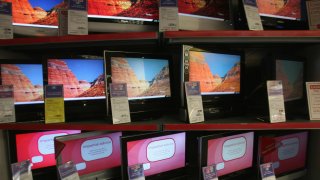
BATH, UNITED KINGDOM – FEBRUARY 27: Digital ready television sets wait to be sold on display in a shop on February 27 2008 in Bath, United Kingdom. The original analogue television signal, used in the UK since the begining of television broadcasts in the 1930s and 1940s, is being switched over to digital, region by region from now until 2012. The new service will offer more channels and is said to be higher quality picture but there are concerns that not all households in the UK are ready for the change. (Photo by Matt Cardy/Getty Images)
What is the difference between “Integrated” DTVs and DTV or HDTV “Monitors”?
An Integrated DTV set is a television with a built-in digital tuner (also referred to as “a DTV”). A digital tuner is also sometimes called a DTV decoder or DTV receiver. If you have an Integrated DTV, you will not need any additional equipment, with the exception of a broadcast antenna (either a rooftop antenna or “rabbit ears” connected to the set), to receive over-the-air digital broadcast programming. Integrated DTVs can also receive and display analog broadcast programming, so you can continue watching analog broadcasts.
In contrast, a DTV Monitor is not capable of receiving digital broadcast programming without additional equipment; it is simply a display device without the processing capability for DTV reception. A digital or HD set-top box must be connected between the antenna and the monitor to receive and display over-the-air digital or HD programming.
If you have a digital or HD “Monitor” and would like to purchase a digital or HD set-top box to view over-the-air programming, confirm with your retailer that the set-top box is compatible with your Monitor.